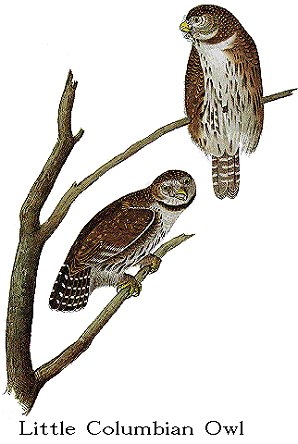
|
Family III. STRIGINAE. OWLS.
GENUS I. SURNIA, Dumeril. DAY-OWL. |
Next >> |

Family |
LITTLE COLUMBIAN OWL. [Northern Pygmy-Owl.] |
| Genus | SURNIA PASSERINOIDES, Temm.
[Glaucidium gnoma.] |
Of this pretty little Owl I can only say that the single specimen from which I made the two figures in the plate before you, was sent to me by Mr.
TOWNSEND, along with the following notice respecting it:--"I shot this bird on
the Columbia river, near Fort Vancouver, in the month of November. I first saw
it on wing about mid-day, and its curious jerking or undulating flight struck me
as extremely peculiar, and induced me to follow and secure it. It soon alighted
upon a high branch of a pine tree, and I shot it with my rifle, the only gun I
had with me, as I was at the time engaged in shooting cranes along the banks of
the river. The specimen is somewhat mutilated, in consequence of having lost
one wing by the ball. The stomach contained nearly the whole body of a
Ruby-crowned Wren, with a few small remnants of beetles and worms. It was a
male; its irides bright yellow; and it measured 7 inches in length. The tail is
exactly 3 inches long, and extends 2 1/4 inches beyond the closed wings."
I have seen several specimens of this Owl in the Edinburgh Museum, which
had also been sent from Fort Vancouver by Dr. MERIDETH GAIRDNER.
CHEVECHE CHEVECHOIDE, Strix passerinoides, Temm. Pl. Col. 344.
LITTLE COLUMBIAN OWL, Strix passerinoides, Aud. Orn. Biog.,
vol. v. p. 271.
Male.
Tail of moderate length, straight, slightly rounded; wings rather short,
much rounded, fourth quill longest, outer three abruptly cut out on the inner
web, the first with its filaments thickened but not recurvate, those of the
second and third also thickened toward the end. General colour of the upper
parts olivaceous brown; the head with numerous small, roundish, yellowish-white
spots, margined with dusky, of which there are two on each feather; the rest of
the upper parts marked with larger, angular, whitish spots; the quills generally
with three small and five large white spots on the outer and inner webs; the
tail barred with transversely oblong white spots, of which there are seven pairs
on the middle feathers. Facial disk brown, spotted with white; throat white,
then a transverse brown band, succeeded by white; the lower parts white, with
longitudinal brownish-black streaks; the sides brown, faintly spotted with
paler. Young with the upper parts rufous, the head with fewer and smaller white
spots; those on the lower part of the hind neck very large; the back, scapulars,
and wing-coverts unspotted; the wings marked as in the adult, but with pale red
spots in the outer, and reddish-white on the inner webs; the tail with only five
bands of spots; the lower parts white, longitudinally streaked with light red,
of which colour are the sides of the body and neck, and a band across the
throat.
Male, 7; wing 3 (7 1/2)/12.
| Next >> |